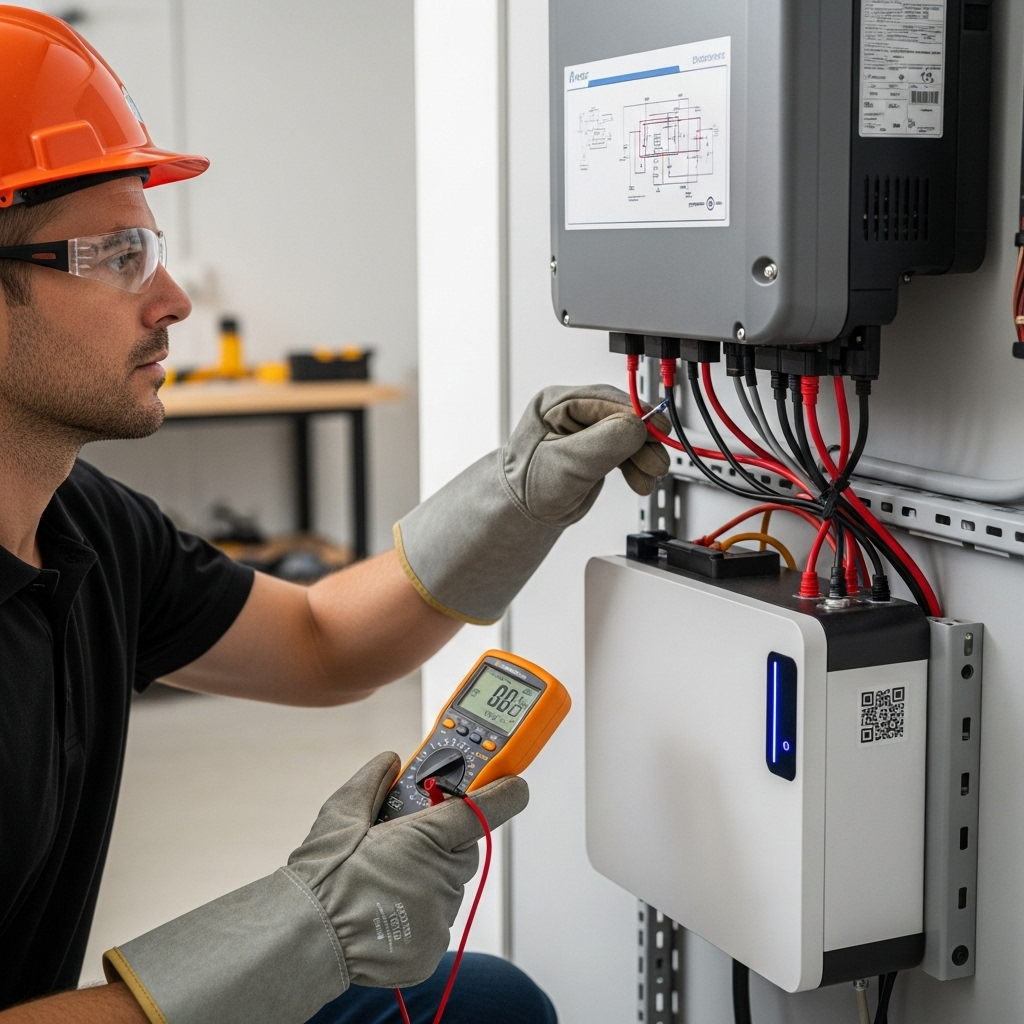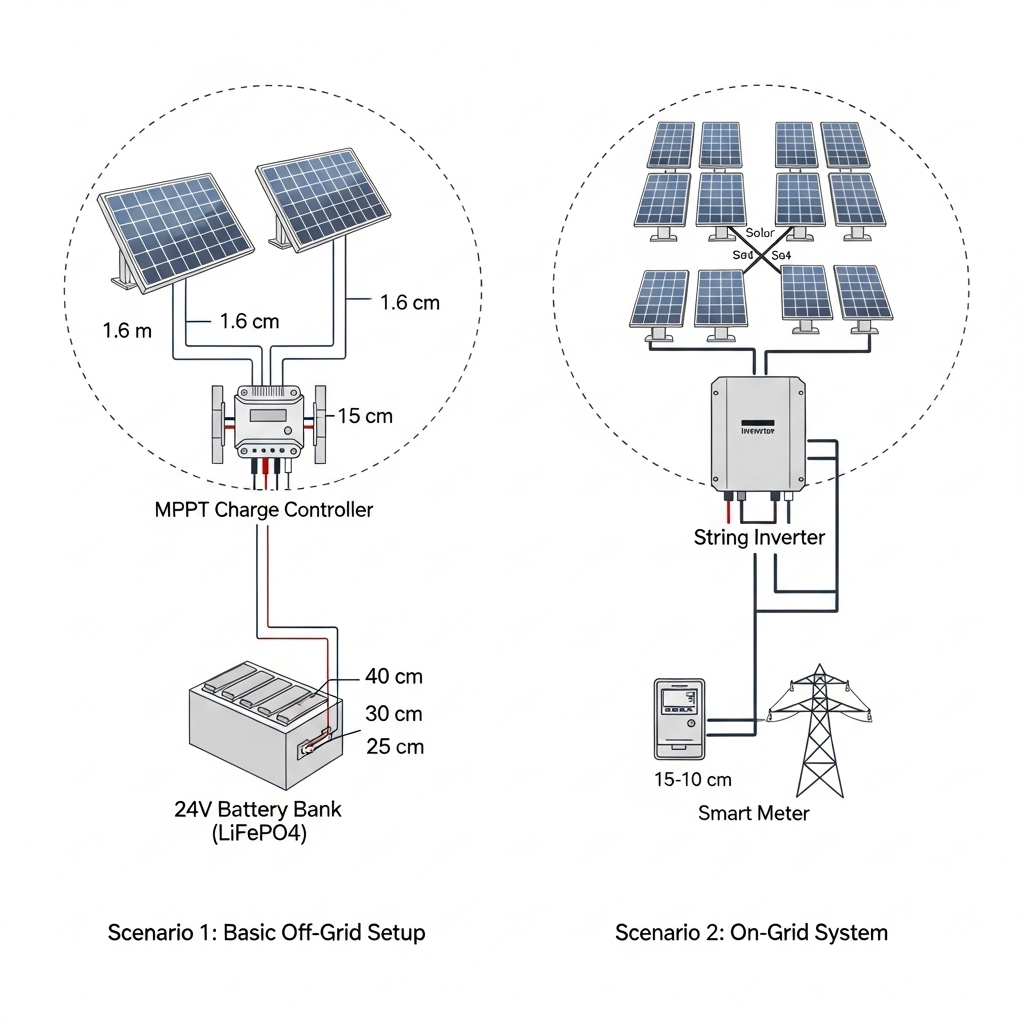For many off-grid cabin owners, a solar PV and battery system is the heart of their energy independence. But as technology and safety standards evolve, so must these systems. This case study explores the essential process of rewiring an older, DIY solar installation to meet the rigorous safety and performance benchmarks of the National Electrical Code (NEC) 2023. Adhering to these standards is not just about compliance; it’s about ensuring the safety, reliability, and longevity of your power system.
Initial System Assessment: Identifying the Gaps
Before any work begins, a thorough evaluation of the existing system is critical. This initial audit reveals discrepancies between the original installation and current safety requirements, forming the blueprint for the upgrade.
Auditing the Original Installation
The subject of our case study is a rustic cabin with a solar setup installed nearly a decade ago. The original system consisted of a small solar array, a lead-acid battery bank, and a basic charge controller and inverter. The audit identified several common issues in older DIY projects: undersized wiring, inadequate overcurrent protection, a lack of proper DC disconnects, and improper grounding—all areas that present significant safety risks.
Key NEC 2023 Requirements for Off-Grid Systems
The NEC is updated every three years to address technological advancements and new safety data. For energy storage systems (ESS), NEC 2023 places a strong emphasis on safety and functionality. According to NEC Article 706, any ESS with a capacity over 1 kWh must comply with specific rules. Key updates relevant to this cabin rewire include stricter guidelines for disconnecting means, emergency shutdown functions, and clear labeling. For one- and two-family dwellings, the code now mandates an 'emergency shutdown function' that can be initiated from an accessible outdoor location, ceasing power export from the ESS. This ensures first responders can safely de-energize the system.
Planning the Rewire: Components and Strategy
The upgrade plan involves a complete overhaul of the system's wiring and safety components. The strategy is to replace the outdated lead-acid batteries with a modern LiFePO4 battery bank, install correctly sized wiring in conduit, and implement a comprehensive set of disconnects and overcurrent protection devices. New components include DC-rated circuit breakers, a main battery disconnect, properly rated fuses, and busbars for clean power distribution. The goal is a system that is not only powerful but also impeccably safe and easy to service.
The Rewiring Process: A Step-by-Step Breakdown
With a solid plan in place, the physical rewiring can commence. This process methodically addresses each of the identified safety gaps, transforming the system into a code-compliant powerhouse.
Enhancing DC Circuit Protection
The first step is installing overcurrent protection devices (OCPDs) on all power sources. This includes placing DC circuit breakers between the solar panels and the charge controller, and between the charge controller and the battery bank. A major fuse or breaker is also installed at the main positive terminal of the new LiFePO4 battery bank. Sizing these OCPDs correctly is crucial; they must be rated to handle the maximum continuous current of the circuit with an appropriate safety margin, typically 125% for continuous loads.
Implementing Proper Disconnects
NEC 2023 requires a means to disconnect the ESS from all other wiring systems. This was achieved by installing a large, readily accessible disconnect switch for the entire battery bank. Additional disconnects were installed for the inverter and solar charge controller, allowing individual components to be safely isolated for maintenance without shutting down the entire system. According to a report from the U.S. Department of Energy, robust microgrids with proper controls and disconnects are key to enhancing community resilience, a principle that applies equally to a standalone cabin. These switches provide a clear, physical break in the circuit, a fundamental aspect of electrical safety.
Grounding and Bonding for System Safety
Proper grounding is one of the most critical and often misunderstood aspects of DIY solar. The rewire project involved establishing a single, robust grounding point for the entire system. The battery's negative terminal was bonded to this ground, and all metallic enclosures—including the inverter chassis, charge controller housing, and panel racking—were bonded to the equipment ground. This ensures that any fault current has a safe path to the earth, preventing electrical shock and equipment damage.
Battery Bank Upgrade and Safety Enhancements
The heart of the system, the battery bank, received a significant upgrade. Moving from lead-acid to Lithium Iron Phosphate (LiFePO4) technology brings numerous benefits but also requires specific wiring and safety considerations.
From Lead-Acid to LiFePO4: Wiring Considerations
LiFePO4 batteries offer higher energy density, longer cycle life, and greater safety compared to their lead-acid counterparts. However, they require a sophisticated Battery Management System (BMS) to monitor cell health and prevent overcharging or over-discharging. The new battery bank has an integrated BMS, and the wiring was sized to handle the higher potential charge and discharge currents. All connections were torqued to manufacturer specifications to ensure minimal resistance and heat generation.
Labeling and Signage: The Final Touch of Compliance
Clear and durable labeling is a non-negotiable requirement of the NEC. The rewired system features prominent, easy-to-read labels identifying all disconnects, system voltages, and potential hazards. A system diagram is posted next to the equipment, providing a clear map of the installation for future maintenance or emergency response. Warning labels, such as 'ELECTRIC SHOCK HAZARD TERMINALS ON THE LINE AND LOAD SIDES MAY BE ENERGIZED IN THE OPEN POSITION,' are placed on disconnects where appropriate.
Verifying Performance and Ensuring Long-Term Reliability
A rewire isn't complete until the system is tested and its long-term health is considered. This final phase ensures the upgrade delivers on its promise of safe, reliable power.
Commissioning the New System
Once all wiring was complete and checked, the system was commissioned. This involved a careful, step-by-step power-up procedure. Voltages were checked at every point, from the solar panels to the AC output of the inverter. All safety features, including the new breakers and the emergency shutdown, were tested to ensure they function as designed. The system performed flawlessly, providing stable power to the cabin's loads.
Monitoring and Maintenance Post-Upgrade
To ensure the system operates efficiently for years to come, ongoing monitoring is essential. As detailed in the Ultimate Reference for Solar Storage Performance, understanding metrics like State of Charge (SoC), Depth of Discharge (DoD), and overall throughput is key to maximizing battery lifespan. The new system includes a battery monitor that provides real-time data, allowing the owner to make informed decisions about energy usage and ensure the battery is operating within its optimal parameters. As the International Renewable Energy Agency (IRENA) notes in its Grid Codes for Renewable Powered Systems report, standardized monitoring and control are vital for system stability, a best practice that DIY installers should adopt.
Disclaimer: This article details a case study and is for informational purposes only. Electrical work should be performed by qualified individuals in accordance with local codes and regulations. This content does not constitute professional electrical or legal advice.
A System Ready for the Future
By investing the time and resources to rewire the cabin's PV-battery system to NEC 2023 standards, the owner has done more than just meet a set of rules. They have created a safer, more reliable, and more efficient power system. This case study demonstrates that with careful planning and attention to detail, a DIY solar project can achieve a professional level of safety and performance, providing peace of mind and energy independence for years to come.
Frequently Asked Questions
Why is NEC 2023 compliance important for a small cabin system?
Compliance is crucial for safety, regardless of system size. It protects inhabitants from electrical shock and fire hazards. It also ensures the system is reliable and that components are not stressed beyond their limits, which extends equipment life. Proper compliance can also be a factor in property insurance.
What is the most critical safety feature in a battery storage system rewire?
While all safety features are important, a correctly sized and installed overcurrent protection system (fuses and breakers) is arguably the most critical. It is the primary defense against short circuits, which can lead to catastrophic equipment failure and fire in high-energy DC systems.
Can I use the same wiring for LiFePO4 batteries as I did for lead-acid?
Not always. While the wire material (copper) is the same, the size (gauge) may need to be different. LiFePO4 batteries often have higher charge and discharge rate capabilities than lead-acid batteries, which can mean higher currents. You must size the wiring based on the maximum current the new battery system can produce and the requirements of the inverter and charge controller, always adhering to NEC ampacity tables.





Leave a comment
All comments are moderated before being published.
This site is protected by hCaptcha and the hCaptcha Privacy Policy and Terms of Service apply.